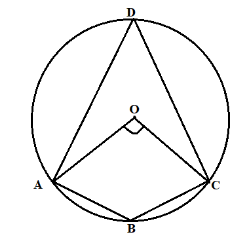
In the adjacent figure, if $\angle AOC = 110^\circ $, then the value of $\angle D$ and $\angle B$ respectively.

A) $55^\circ ,125^\circ $
B) $55^\circ ,110^\circ $
C) $110^\circ ,25^\circ $
D) $125^\circ ,55^\circ $

Answer
576.6k+ views
Hint: First, find the reflex of the central angle, then find the angle formed by the chords of a circle which is half of the reflex of the central angle and then apply Sum of pair of opposite angles of a cyclic quadrilateral is \[180^\circ \], which gives the required result.
Complete step-by-step answer:
We have given the value of the angle \[\angle AOC = 110^\circ \] in the adjacent figure and in this figure, there is a cyclic quadrilateral.
The goal of the problem is to find the value of angles \[\angle B\] and \[\angle D\]
It is given to use that:
\[\angle AOC = 110^\circ \]
We know by the property of the cyclic quadrilateral that the angle at the circumference of the circle is just half of the angle at the center of the circle. That is,
$\angle ADC = \dfrac{1}{2}\left( {\angle AOC} \right)$
Substitute the value of the angle AOC into the above equation:
$\angle ADC = \dfrac{1}{2}\left( {110^\circ } \right)$
$\angle ADC = 55^\circ $
So, the value of the $\angle D$ is $55^\circ $.
Now, we will find the angle $\angle B$ by applying the property of the cyclic quadrilateral. The property says that the sum of the opposite angle of a cyclic quadrilateral is $180^\circ $ . That is,
$\angle D + \angle B = 180^\circ $
Now, we will substitute the value of the angle D into the above equation:
\[\begin{gathered}
55^\circ + \angle B = 180^\circ \\
\angle B = 180^\circ - 55^\circ \\
\angle B = 125^\circ \\
\end{gathered} \]
Thus, the value of angle B is $125^\circ $.
Therefore, the required values are:
$\angle D = 55^\circ $ and $\angle B = 125^\circ $.
Therefore, option A is correct in which $55^\circ ,125^\circ $ are the angles.
Note: In this type of question use the properties of the angle sum of a cyclic quadrilateral. And here we cannot find the value of $\angle B$, as there is no relation between the central angle and $\angle B$, so first we have to find the angle $\angle D$ and then we can proceed to find the value of another angle.
Complete step-by-step answer:
We have given the value of the angle \[\angle AOC = 110^\circ \] in the adjacent figure and in this figure, there is a cyclic quadrilateral.
The goal of the problem is to find the value of angles \[\angle B\] and \[\angle D\]
It is given to use that:
\[\angle AOC = 110^\circ \]
We know by the property of the cyclic quadrilateral that the angle at the circumference of the circle is just half of the angle at the center of the circle. That is,
$\angle ADC = \dfrac{1}{2}\left( {\angle AOC} \right)$
Substitute the value of the angle AOC into the above equation:
$\angle ADC = \dfrac{1}{2}\left( {110^\circ } \right)$
$\angle ADC = 55^\circ $
So, the value of the $\angle D$ is $55^\circ $.
Now, we will find the angle $\angle B$ by applying the property of the cyclic quadrilateral. The property says that the sum of the opposite angle of a cyclic quadrilateral is $180^\circ $ . That is,
$\angle D + \angle B = 180^\circ $
Now, we will substitute the value of the angle D into the above equation:
\[\begin{gathered}
55^\circ + \angle B = 180^\circ \\
\angle B = 180^\circ - 55^\circ \\
\angle B = 125^\circ \\
\end{gathered} \]
Thus, the value of angle B is $125^\circ $.
Therefore, the required values are:
$\angle D = 55^\circ $ and $\angle B = 125^\circ $.
Therefore, option A is correct in which $55^\circ ,125^\circ $ are the angles.
Note: In this type of question use the properties of the angle sum of a cyclic quadrilateral. And here we cannot find the value of $\angle B$, as there is no relation between the central angle and $\angle B$, so first we have to find the angle $\angle D$ and then we can proceed to find the value of another angle.
Recently Updated Pages
Master Class 8 Social Science: Engaging Questions & Answers for Success

Master Class 8 Maths: Engaging Questions & Answers for Success

Master Class 8 Science: Engaging Questions & Answers for Success

Class 8 Question and Answer - Your Ultimate Solutions Guide

Master Class 8 English: Engaging Questions & Answers for Success

Why are manures considered better than fertilizers class 11 biology CBSE

Trending doubts
What is BLO What is the full form of BLO class 8 social science CBSE

Citizens of India can vote at the age of A 18 years class 8 social science CBSE

Full form of STD, ISD and PCO

Right to vote is a AFundamental Right BFundamental class 8 social science CBSE

What is the difference between rai and mustard see class 8 biology CBSE

Summary of the poem Where the Mind is Without Fear class 8 english CBSE





